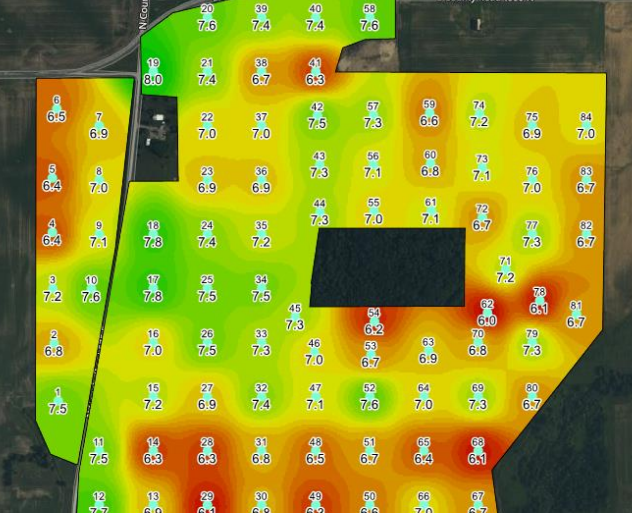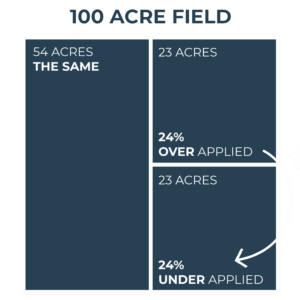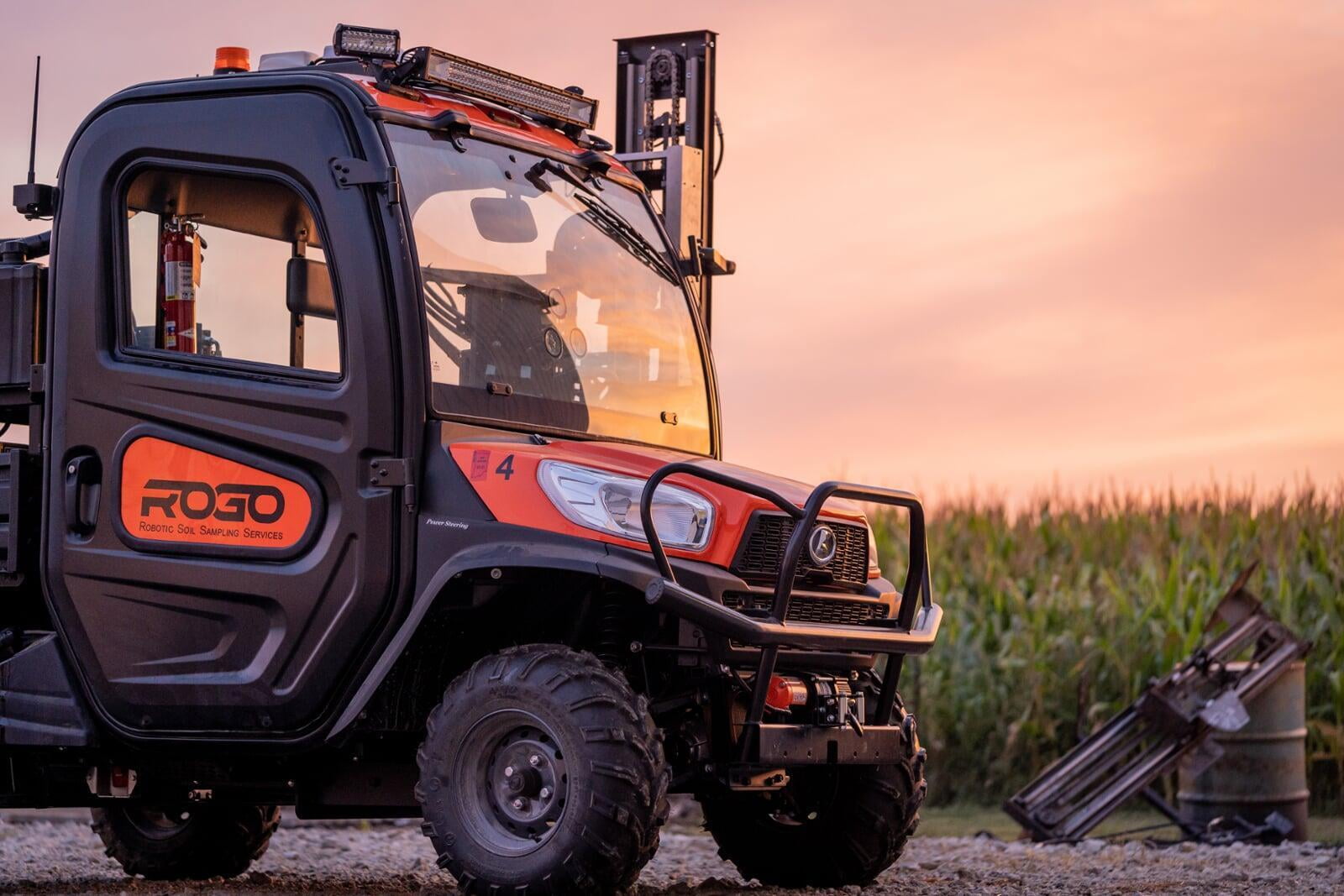Soil Sampling Accuracy: Untapped Potential in Nutrient Management
Fertilizer application is only as precise as the data it’s given – and traditional soil sampling is far from the most exact of precision ag practices. Faced with labor shortages, inefficient technology and a lack of transparency, many soil sampling solutions prioritize efficiency over accuracy. Robotic sampling consistently identifies the hidden areas in every field where nutrients are left below the critical level. By improving nutrition in these areas, growers quickly recoup the cost of more advanced sampling methods.
Practical Challenges with Sampling Accuracy

Ideally, soil sampling creates a nutrient map that’s representative of the soil makeup. For growers sampling 6-core, 2.5 acre grids, each individual core controls $30-70 of fertilizer spend. Even small mistakes, repeated across hundreds of cores, can significantly warp fertilizer application.
Taking quality samples requires consistency and attention to detail – 2 qualities not usually found while speeding through a field on an ATV.
Variation in depth, extraction quality, and core location contaminate the sample, causing some parts of the field to be over- and under-fertilized.
Inconsistent Sample Depth
“Not taking a representative depth soil core is by far the biggest problem,” says Drew Schumacher, CEO of Indiana-based soil sampler ROGO. P, K and pH levels are typically concentrated near the soil’s surface, and recommendation models are closely calibrated for samples from specific depths. “In most soils, every 1/2″ that the probe is too shallow or too deep changes the nutrient content 5-10%,” says Schumacher.
Poor Probe Design and Soil Flow
Not all probes are equal. Depending on the design, backpressure from soil friction can build up inside the probe, forcing soil around the inlet rather than inside. Most probes are designed for a particular kind of soil and may not capture a complete core when the conditions are wet, dry, sandy, or anything else out of the ordinary. Some models (particularly common on hydraulic probes) also have inlets that are too narrow, restricting soil flow and keeping it from extracting the full depth of the core.
Ideally, samplers would discard bad or damaged cores – but this level of attention to detail is unheard of throughout the industry.
What would the ideal probe design look like? This video has all the details.
Variation in Core Location
Nutrient composition changes significantly inside a few yards, especially around waterways, buildings, and other internal characteristics. Sampling in slightly different places from year to year can cause the sample to show different results.
GPS accuracy and driver error combine to create wide discrepancies in sample location.

Inconsistent sample depth, poor probe design, and variation in core location all lead to a less representative sample and reduce accuracy before the soil even reaches the lab.
Impact on Fertilizer Management
This isn’t just an issue for agronomists, it impacts fertilizer application and yield potential.
Variable rate applicators spread a precise prescription of inputs – all based on sample data. In a best-case scenario, traditional soil sampling has a margin of error of 14%, which some robotic methods can reduce to under 5% (Read the Fertility Study). With this 9% error reduction, fertilizer spend is reallocated, often affecting roughly 50% of samples, some with increased/decreased application rates of up to 20%.

Even if growers are overapplying by 10%, some areas are still not achieving the critical level of nutrients, while others are receiving 15-20% more than they need.
As sampling accuracy increases, fewer areas experience either under or over-application, reallocating fertilizer often without significantly changing the total spend. Precise measurement simply redirects fertilizer budgets toward the acres and plots where they can have the greatest impact.
The Business Decision: What’s the alternative, and is it practical?
Error isn’t inherent in the soil sampling process, it’s the result of inconsistent and imprecise sampling methods that can be corrected with robotics.
Robotic sampling creates value by identifying the hidden areas in your acres that are still below critical nutrient thresholds. By applying fertilizer more precisely, growers can see higher yields without increasing input costs.
It’s common knowledge that adding P, K and lime in these critical areas increases their yield by 5-10%. Using estimates from the University of Illinois Revised 2024 Farm Budgets, robotic sampling is profitable if 6% (corn) or 7% (soybeans) of your field remains below these thresholds with traditional sampling.*
Box | Description | Corn | Soybeans |
A | Revenue per Acre | $960 | $762 |
B | Yield Increase to Offset Cost of Robotic Sampling Tools ($4* / A) | 0.42% | 0.52% |
C | Untapped Yield Growth Potential in Areas Below Critical Threshold | 7% | 7% |
D | % of Field Below Threshold to Offset Cost (B / C) | 6% | 7% |
*Conservatively assuming robotic sampling to be $4/ac more expensive than traditional sampling
If more than 7% of your acres are still below their critical threshold with traditional sampling, robotic sampling is a worthwhile investment.
Looking to the Future
Accuracy problems are only getting worse. Sampling labor is becoming more seasonal, causing consistency and quality to decrease further, and there is still no accountability for accuracy built into the retailer system.
Leading retailers are providing advanced sampling to their growers at an upcharge using partners like ROGO. ROGO is a precision agriculture company based in Remington, IN that uses robotics and software to automate the soil sampling process. With probes that reach the correct depth every time, cutting tips to control soil residue and GPS accurate within an inch, ROGO sampling reduces margin of error from 14% to 5%, helping you build a fertility program on data that you trust.
Ready to Get robotic sampling On your Acres?
Give us a call to have your acres sampled robotically this season and get more accurate results

